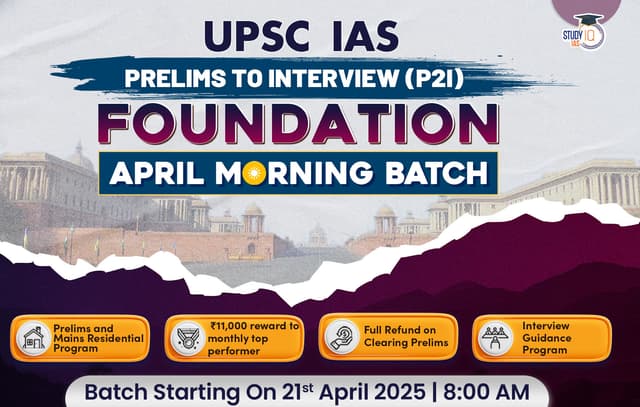Daily Quiz 18 February 2024
Quiz-summary
0 of 4 questions completed
Questions:
- 1
- 2
- 3
- 4
Information
- Click on – ‘Start Quiz’ button
- Solve Questions
- Click on ‘Next’ button
- Click on ‘Finish Quiz’ button
- Now click on ‘View Questions’ button – here you will see solutions and links.
- The test contains a total of 5 questions.
- Click on the most appropriate option to mark it as your answer.
- You will be awarded Two marks for each correct answer.
- You can change your answer by clicking on some other option.
- A Number list of all questions appears at the top side of the screen.
- You can access the questions in any order by clicking on the question number given on the number list.
- You can use rough sheets while taking the test.
- Do not use calculators, log tables, dictionaries, or any other printed/online reference material during the test.
- Do not click the button “Finish Quiz” before completing the test. A test once submitted cannot be resumed.
You have already completed the quiz before. Hence you can not start it again.
Quiz is loading...
You must sign in or sign up to start the quiz.
You have to finish following quiz, to start this quiz:
- 1
- 2
- 3
- 4
- Answered
- Review
-
Question 1 of 4
1. Question
1 pointsWhich one of the following statements is not correct with reference to cocoa plant:
Correct
Answer: C
Explanation:
● Cocoa is an important commercial plantation crop of the world. Cocoa is a crop of humid tropics and so it was introduced as a mixed crop in India in areas where the environments suit the crop. It is cultivated in coconut and arecanut plantations large scale from 1970 onwards. It is grown as an under- storey intercrop with sufficient shade in southern states of India. In India, the current production is about 12,000 Metric Tonnes and Tamil Nadu produces about 400 Metric Tonnes.
● The natural habitat of the cocoa tree is in the lower storey of the evergreen rainforest, and climatic factors, particularly temperature and rainfall, are important in encouraging optimum growth. Cocoa is a perennial crop, and it can withstand different seasonal variations with good health and yield potential. Cocoa is normally cultivated at altitudes upto 1200 m above MSL with an annual rainfall of 1000mm to 2000mm and a relative humidity of 80 % with maximum 350C and minimum temperature of 150C. Cocoa can be grown as intercrop in coconut and arecanut gardens. It is predominantly grown on red laterite soils. It thrives well on wide range of soil types with pH ranging from 4.5- 8.0 with optimum being 6.5- 7.0.
● Cocoa is a shade loving plant. During its seedling period it requires about 50% shade and later the shade requirement is about 40%. The plant is grown as a mixed crop with other plants like spices and rubber mainly under rainfed conditions. Cocoa is planted as an intercrop in coconut and arecanut gardens.
● Black Pod rot (Phytophthora palmivora) infection appears as chocolate brown spot, which spreads rapidly and soon occupies the entire surface of the pod. As the disease advances, a whitish growth of fungus consisting of fungal sporangia is produced over the affected pod surface. Ultimately, the affected pods turn brown to black. The internal tissues as well as the beans become discolored as a result of infection. The beans in the infected pods approaching ripeness may escape infection because they are separated from the husk on ripening.Incorrect
Answer: C
Explanation:
● Cocoa is an important commercial plantation crop of the world. Cocoa is a crop of humid tropics and so it was introduced as a mixed crop in India in areas where the environments suit the crop. It is cultivated in coconut and arecanut plantations large scale from 1970 onwards. It is grown as an under- storey intercrop with sufficient shade in southern states of India. In India, the current production is about 12,000 Metric Tonnes and Tamil Nadu produces about 400 Metric Tonnes.
● The natural habitat of the cocoa tree is in the lower storey of the evergreen rainforest, and climatic factors, particularly temperature and rainfall, are important in encouraging optimum growth. Cocoa is a perennial crop, and it can withstand different seasonal variations with good health and yield potential. Cocoa is normally cultivated at altitudes upto 1200 m above MSL with an annual rainfall of 1000mm to 2000mm and a relative humidity of 80 % with maximum 350C and minimum temperature of 150C. Cocoa can be grown as intercrop in coconut and arecanut gardens. It is predominantly grown on red laterite soils. It thrives well on wide range of soil types with pH ranging from 4.5- 8.0 with optimum being 6.5- 7.0.
● Cocoa is a shade loving plant. During its seedling period it requires about 50% shade and later the shade requirement is about 40%. The plant is grown as a mixed crop with other plants like spices and rubber mainly under rainfed conditions. Cocoa is planted as an intercrop in coconut and arecanut gardens.
● Black Pod rot (Phytophthora palmivora) infection appears as chocolate brown spot, which spreads rapidly and soon occupies the entire surface of the pod. As the disease advances, a whitish growth of fungus consisting of fungal sporangia is produced over the affected pod surface. Ultimately, the affected pods turn brown to black. The internal tissues as well as the beans become discolored as a result of infection. The beans in the infected pods approaching ripeness may escape infection because they are separated from the husk on ripening. -
Question 2 of 4
2. Question
1 pointsThe Corruption Perceptions Index (CPI), recently seen in the news, is released by:
Correct
Answer: B
Explanation:
- Option B is correct: Corruption Perceptions Index (CPI), recently seen in the news, is released by Transparency International. The index uses a scale of 0 to 100, where 0 is highly corrupt and 100 is corruption clean. The rank tells the country’s position relative to other countries in the index. The score for each country is derived from a minimum of three data sources, selected from 13 distinct corruption surveys and assessments. These sources are gathered by a range of reputed organisations, such as the World Bank and the World Economic Forum.
Transparency International gave India a CPI score of 38. In 2023, India’s overall score was 39 while in 2022, it was 40. There is a decline in the score of India on CPI. In the Asia-Pacific region, the average score for the region has dropped by one point to 44 as the countries are still failing to deliver on anti-corruption pledges.
Incorrect
Answer: B
Explanation:
- Option B is correct: Corruption Perceptions Index (CPI), recently seen in the news, is released by Transparency International. The index uses a scale of 0 to 100, where 0 is highly corrupt and 100 is corruption clean. The rank tells the country’s position relative to other countries in the index. The score for each country is derived from a minimum of three data sources, selected from 13 distinct corruption surveys and assessments. These sources are gathered by a range of reputed organisations, such as the World Bank and the World Economic Forum.
Transparency International gave India a CPI score of 38. In 2023, India’s overall score was 39 while in 2022, it was 40. There is a decline in the score of India on CPI. In the Asia-Pacific region, the average score for the region has dropped by one point to 44 as the countries are still failing to deliver on anti-corruption pledges.
-
Question 3 of 4
3. Question
1 pointsConsider the following statements with reference to Earth’s inner core:
- It is molten and surrounded by a solid metal outer core.
- It is mostly made of metal, including silica and aluminum.
Which of the statements given above is/are correct?
Correct
Answer: D
Explanation:
Statements 1 and 2 are not correct: Earth’s inner core is surrounded by an outer core, and the interface between the two, around 5,100 kilometres below the planet’s surface, is a mysterious realm. Previous seismic studies revealed that the inner core is solid metal and rotates within a super-hot molten outer core, also mostly made of metal, including iron and nickel. Researchers have tracked how that rotation speeds up and slows down over time, and have discovered that it is spinning at a slightly different rate from the rest of Earth.
Incorrect
Answer: D
Explanation:
Statements 1 and 2 are not correct: Earth’s inner core is surrounded by an outer core, and the interface between the two, around 5,100 kilometres below the planet’s surface, is a mysterious realm. Previous seismic studies revealed that the inner core is solid metal and rotates within a super-hot molten outer core, also mostly made of metal, including iron and nickel. Researchers have tracked how that rotation speeds up and slows down over time, and have discovered that it is spinning at a slightly different rate from the rest of Earth.
-
Question 4 of 4
4. Question
1 pointsConsider the following statements with reference to Saint Ravidas:
- He was one of the first people to argue that all Indians should have a set of basic human rights.
- His devotional songs and poems are included in the Sikh Scripture, Guru Granth Sahib.
Which of the statements given above is/are correct?
Correct
Answer: C
Explanation:
- Statements 1 and 2 are correct: Guru Ravidas was born at the end of the 14th century in Seer Govardhanpur village, Uttar Pradesh, India. He was born into a low caste family who were regarded as untouchables. Guru Ravidas was one of the first people to argue that all Indians should have a set of basic human rights. He became an eminent figure in the Bhakti Movement and taught spirituality and tried to bring forward a message of equality based on freedom from the oppression of the Indian caste system.
41 of his devotional songs and poems are included in the Sikh Scriptures, Guru Granth Sahib. Meera bai, a revered figure in Hindu spiritualism is said to have considered Guru Ravidas as her spiritual Guru. The Guru’s teachings now form the basis of the Ravidassia religion. Ravidassias believe that Guru Ravidas should be treated as a saint just like the other gurus, as he lived before the first Sikh Guru and his teachings were studied by the Sikh Gurus. In recent years, this has caused conflict with Sikhs and has led to Ravidassia breaking away from the orthodox Sikh structure.
Incorrect
Answer: C
Explanation:
- Statements 1 and 2 are correct: Guru Ravidas was born at the end of the 14th century in Seer Govardhanpur village, Uttar Pradesh, India. He was born into a low caste family who were regarded as untouchables. Guru Ravidas was one of the first people to argue that all Indians should have a set of basic human rights. He became an eminent figure in the Bhakti Movement and taught spirituality and tried to bring forward a message of equality based on freedom from the oppression of the Indian caste system.
41 of his devotional songs and poems are included in the Sikh Scriptures, Guru Granth Sahib. Meera bai, a revered figure in Hindu spiritualism is said to have considered Guru Ravidas as her spiritual Guru. The Guru’s teachings now form the basis of the Ravidassia religion. Ravidassias believe that Guru Ravidas should be treated as a saint just like the other gurus, as he lived before the first Sikh Guru and his teachings were studied by the Sikh Gurus. In recent years, this has caused conflict with Sikhs and has led to Ravidassia breaking away from the orthodox Sikh structure.
Results
0 of 4 questions answered correctly
Your time:
Time has elapsed
You have reached 0 of 0 points, (0)
| Average score |
|
| Your score |
|
Categories
- Not categorized 0%
| Pos. | Name | Entered on | Points | Result |
|---|---|---|---|---|
| Table is loading | ||||
| No data available | ||||
Sharing is caring!


 Daily Quiz 17 April 2025
Daily Quiz 17 April 2025





















